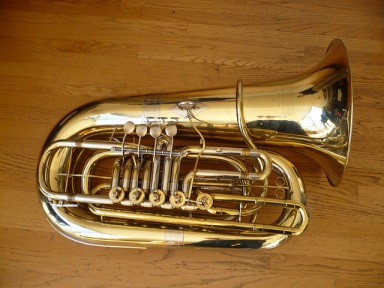The tuba is a member of the brass family, having the largest size and lowest pitch. Because of its large size the tuba is extremely strenuous to both study and play, and therefore one of the most challenging instruments. As you can imagine, a brass instrument of this size is not always the easiest for younger students to carry around. Therefore, in the case of the tuba, the size of the student is sometimes a factor in the choice of this instrument.
Most tubas will usually weigh 30 to 50 lbs with an additional 5 to 15 lbs for the carrying case, and if one were to unfurl and stretch the instrument all the way out, the length would be about 27 feet. Therefore, if a smaller sized or very young student is interested in learning the tuba, it may be best to start with the baritone and make the switch later. The instrument called the baritone is much smaller, but very similar in function.
Another version of the tuba that actually goes around the middle of the musician and is easier to carry is the sousaphone. It is used mainly for marching band, and is much more functional for this purpose. However, although it is lighter and easier to carry, it is not smaller and still would be difficult for beginners of small stature.
Anyone can learn the tuba, although it may take them months to study and years to master. Once learned however, the tuba can be a fun and fulfilling instrument to play. One of the best and most straightforward ways to learn the tuba is to go to a class. Classes can be found in many places, primarily in schools and community centers. You can go to one of these and easily sign up for lessons in a matter of minutes, as most are completely open to the public for a small fee. At a class like this you will learn the tuba efficiently, quickly, and skillfully.
The main two problems with group classes like these are the price and the group setting. Some people just don’t have the money it takes to learn the tuba at a school. Others don’t want to try to learn the tuba within a group setting because they study much better one on one. There are solutions for those problems following.
If the group setting thing bothers you, you can find a private tutor to help you learn the tuba almost as easily as finding a school. The trick is in knowing where to look. One great place to check is in classifieds, online or in newspapers, to see if any local tutors are willing to take you on as a private student. You can also check with music stores and schools to try to find these.
And if money is your problem, don’t worry. There are thousands of educational resources completely for free online, and you can learn the tuba with one of these. Instructional videos, tutorial articles, and step by step how-to’s are just a few of the invaluable options you can find for free on the internet.
Photo Credit:Charles Hutchins
Login to
Don't have an account?
Access Free
Access Free




